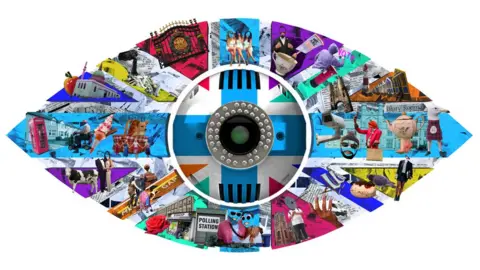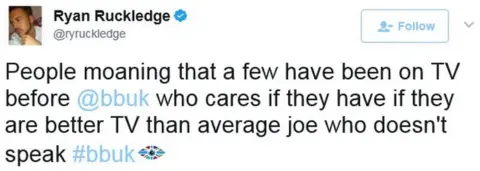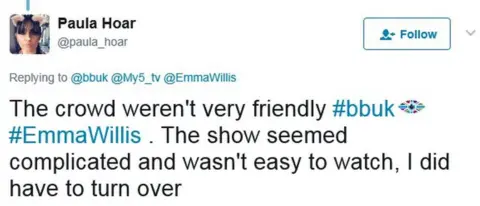Big Brother: Who is still watching it?
 Channel 5
Channel 5Big Brother has returned - with reactions ranging from glee to groaning.
For many, when the series appears in the TV schedules, their response is one of total indifference and tumbleweed.
But to its loyal fanbase, the show remains addictive television, 17 years after it debuted.
Its series opening on Monday was watched live by an average of 1.2 million viewers - down on last year's premiere, which attracted an average of 1.4 million.
The dizzy heights of series two, for example, which saw a total of 13.7 million viewers tune in to Channel 4 to see Brian Dowling crowned the winner, are a distant memory.
How has the show changed since its debut, and who is still tuning in? Let's take a look.

The new breed of contestant
 PA
PAMany of those who tune into the first episode of a series do so in order to decide whether they're going to bother with the rest.
You can usually judge from the contestants' introductions whether it's going to be a must-watch or must-avoid series.
Interestingly, the type of contestants the show now casts has started to change.
Reality TV fans will recognise Chanelle McCleary, who went into the house on Monday night, from Ex On The Beach, Take Me Out and Dinner Date.
 Twitter
TwitterIn another year, such television credits might even have qualified her for appearing in Celebrity Big Brother.
But this year, producers are actively seeking familiar faces from shows like ITV2's Ibiza Weekender. The reigning Miss Nigeria UK also entered the house on Monday.
Channel 5 seems to have recognised that recognisability is good, even when it comes to the non-celebrity series.
But many of the show's fans object to the blurring of the celebrity lines, with one viewer tweeting: "Why has half of Ex On The Beach gone in Big Brother - thought they were meant to be nobodies?"

Celebrity Big Brother remains more popular
 Getty Images
Getty ImagesOne reason producers might be trying to put more familiar faces on screen is that Celebrity Big Brother, which is broadcast twice a year in January and August, continues to be a bigger draw than the regular series.
The most recent celebrity version was down on last year but still attracted a fairly healthy 1.8 million when it launched in January.
The names involved aren't usually too bad - most people have heard of Katie Hopkins, Christopher Biggins, Jedward and Coleen Nolan - but it's a very specific kind of celebrity who takes part.
 Channel 5
Channel 5You probably won't see Rihanna or Jennifer Lawrence in there anytime soon, but many of the contestants that do appear are recognisable enough names.
Provided you're a dedicated Loose Women viewer.
This is perhaps what allows fans to feel a familiarity with the series without having to spend too long getting to know lots of new faces at once.
Another huge part of CBB's appeal is the shorter series duration. It's much less of a commitment to sign up for watching a month-long nightly show, than one that drags on for almost three times that length.

The Netflix effect
 Getty Images
Getty ImagesIf you'd said words like "iPlayer" and "Netflix" to someone in 2000 they would have looked at you blankly because of the alien language you were speaking.
And yet, 17 years on, a huge number of those very same people have deserted terrestrial TV for catch-up and streaming services.
The idea of buying the Radio Times and looking at what's scheduled on your five TV channels on any given night seems ridiculous given the abundance of choice we now have.
In an average day in the office, you're far more likely to hear colleagues talking about Netflix shows such as 13 Reasons Why or Stranger Things than Big Brother.
Such programmes are exciting and new. They are the water cooler TV shows that Big Brother once was.
Having said that, it's worth bearing in mind that 1.2 million BB viewers is not to be sniffed at - that's a huge figure for Channel 5 and one that many other streaming services or Freeview, satellite and cable channels would kill for.

Okay, seriously though, who is still watching?
 PA
PAThe format broadly remains the same, and the programme is past its ratings peak - so who are the people hanging on?
Well, the data may not be available yet for Monday evening's show, but figures for the launch of the last series of Big Brother offer some clues.
Here's a breakdown according to Barb, the ratings people.
- 70% of the Big Brother's audience is female
- The age group the show is most popular with is 45-54 year olds
- The show is considerably more popular with lower middle class and working class viewers than it is with middle or upper middle class viewers
- Nearly a quarter of viewers live in the north of England, which is the region that most loves BB. 19% are in London. Scotland (14%) and Wales (7%) care far less keen on Big Brother
It's worth remembering that these figures vary slightly for each episode of the series, but the broad trends are the same.
Celebrity Big Brother follows many of the same patters but skews slightly younger.
Much more fun than looking at numbers though, is looking Twitter. Here's a selection of what some viewers were saying on Monday evening:
 Twitter
Twitter Twitter
Twitter Twitter
Twitter Twitter
Twitter Twitter
Twitter Twitter
Twitter
Follow us on Facebook, on Twitter @BBCNewsEnts, or on Instagram at bbcnewsents. If you have a story suggestion email [email protected].
